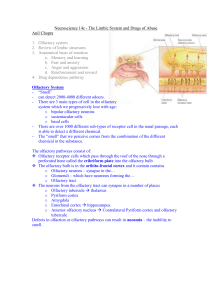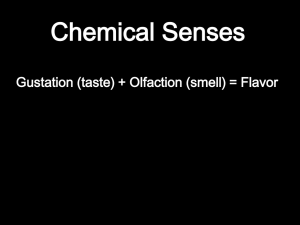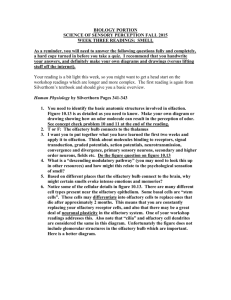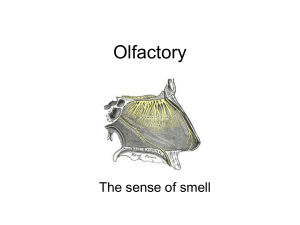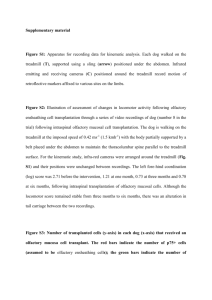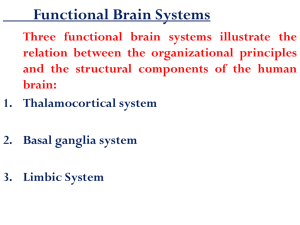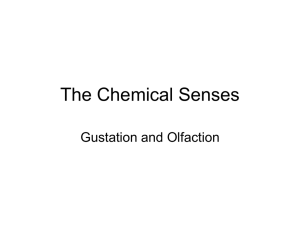OLFACTORY PATHWAYS AND LIMBIC SYSTEM
advertisement
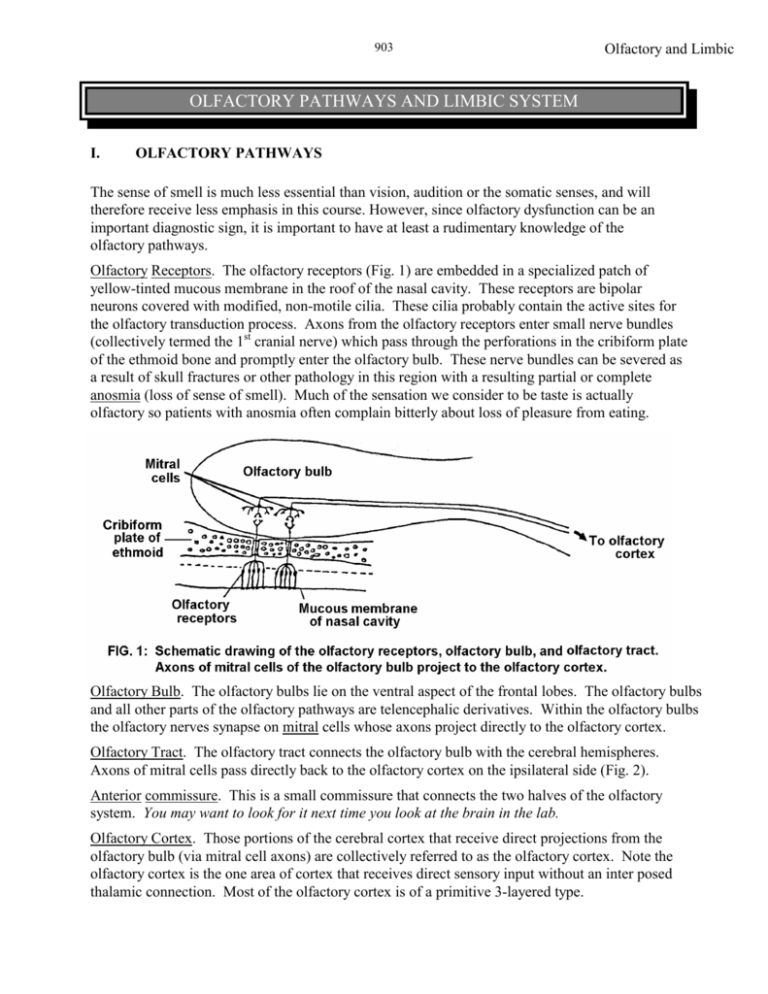
903 Olfactory and Limbic OLFACTORY PATHWAYS AND LIMBIC SYSTEM I. OLFACTORY PATHWAYS The sense of smell is much less essential than vision, audition or the somatic senses, and will therefore receive less emphasis in this course. However, since olfactory dysfunction can be an important diagnostic sign, it is important to have at least a rudimentary knowledge of the olfactory pathways. Olfactory Receptors. The olfactory receptors (Fig. 1) are embedded in a specialized patch of yellow-tinted mucous membrane in the roof of the nasal cavity. These receptors are bipolar neurons covered with modified, non-motile cilia. These cilia probably contain the active sites for the olfactory transduction process. Axons from the olfactory receptors enter small nerve bundles (collectively termed the 1st cranial nerve) which pass through the perforations in the cribiform plate of the ethmoid bone and promptly enter the olfactory bulb. These nerve bundles can be severed as a result of skull fractures or other pathology in this region with a resulting partial or complete anosmia (loss of sense of smell). Much of the sensation we consider to be taste is actually olfactory so patients with anosmia often complain bitterly about loss of pleasure from eating. Olfactory Bulb. The olfactory bulbs lie on the ventral aspect of the frontal lobes. The olfactory bulbs and all other parts of the olfactory pathways are telencephalic derivatives. Within the olfactory bulbs the olfactory nerves synapse on mitral cells whose axons project directly to the olfactory cortex. Olfactory Tract. The olfactory tract connects the olfactory bulb with the cerebral hemispheres. Axons of mitral cells pass directly back to the olfactory cortex on the ipsilateral side (Fig. 2). Anterior commissure. This is a small commissure that connects the two halves of the olfactory system. You may want to look for it next time you look at the brain in the lab. Olfactory Cortex. Those portions of the cerebral cortex that receive direct projections from the olfactory bulb (via mitral cell axons) are collectively referred to as the olfactory cortex. Note the olfactory cortex is the one area of cortex that receives direct sensory input without an inter posed thalamic connection. Most of the olfactory cortex is of a primitive 3-layered type. Olfactory and Limbic 904 The olfactory cortex is located on the base of the frontal lobe and medial aspect of the temporal lobe (Fig. 2). On the base of the frontal lobe it overlies the anterior perforated substance through which the striate arteries enter the interior of the brain (review these arteries in the cortex handout if you have forgotten their significance!). On the temporal lobe the olfactory cortex covers the rostral portion of the parahippocampal gyrus including a medial bulge known as the uncus or uncinate gyrus (Fig. 2). The uncus is of clinical significance for two reasons: 1) seizures often originate in this area (so-called uncinate fits). These seizures are preceded by hallucinations of disagreeable odors, reflecting the olfactory function of the. 2) When the volume of the temporal lobe is increased due to tumors, hemorrhage or edema, the uncus can press against the brainstem and cranial nerves with serious consequences (so-called uncal herniation). The herniating uncus and adjacent part of the parahippocampal gyrus push the brainstem to the opposite side, resulting in damage by pressure against the taut free margin of the tentorium. Thus, brainstem damage is typically contralateral to the side of the herniation. Recall also from Dr. Harting’s lecture that the oculomotor nerve can be damaged on the side that is ipsilateral to the herniation. From the olfactory cortex, olfactory information is relayed via the mediodorsal nucleus of the thalamus to the insular and orbitofrontal cortex. The insular cortex, which is buried in the depths of the Sylvian fissure, also receives taste input from the medial part of VPM and is believed to be the site where olfactory and taste information is integrated to produce the sensation that can be termed flavor. The orbitofrontal cortex on the base of the frontal lobe (Fig. 2) has an unknown role in olfactory perception. When testing for olfactory impairment it is necessary to keep two things in mind: 1) The nasal cavities and olfactory pathways up to the level of the anterior commissure are completely separate so each nostril can be tested separately in order to detect a unilateral anosmia; 2) There are endings of the trigeminal nerve (free nerve endings) within the nasal cavity which respond to irritating or pungent odors. Odors of this type must therefore be avoided in testing for anosmia. 905 II. Olfactory and Limbic LIMBIC SYSTEM The limbic lobe (from limbus, Lt. = border) is a ring of cortex on the medial aspect of the cerebral hemisphere (Fig. 3). The ring of cortex consists of the cingulate gyrus, parahippocampal gyrus, and septal cortex. These 3 cortical areas are connected via the cingulum (see Fig. 12 in Cerebral Cortex handout). The cortical areas within the limbic lobe, together with certain adjacent deep structures, are known as the limbic system. The areas that are usually included within the limbic system are: 1) the limbic lobe, 2) the hippocampal formation and fornix, 3) the amygdala, 4) the septal area, 5) the mammillary bodies (or in some accounts, the entire hypothalamus), and 6) the anterior nuclei of the thalamus. These areas are all closely interconnected by way of one or more of the following important pathways: fornix, mammillothalamic tract, the stria terminalis and the cingulum and appear to function together for the generation of certain emotional and visceral responses as described below. These structures are also sometimes referred to as Papez circuit after the neuroanatomist who pointed out the circular nature of the interconnections (see Fig. 4). Olfactory and Limbic 906 Many of the limbic structures developed in relation to the olfactory system in primitive vertebrates; hence the term rhinencephalon (literally, “nose brain”) is often used to denote the same areas. In humans, however, most of these areas have little or nothing to do with the sense of smell and the term rhinencephalon seems somewhat misleading (although arguments supporting the use of this term will be found in some textbooks). The anatomy and functions of the different components of the limbic system will first be described individually, followed by a discussion of the system as a whole. A. Hippocampal Formation. The hippocampal formation is a phylogenetically old part of the cerebral cortex located within the temporal lobe. Like the insular cortex, the hippocampal formation has been pushed beneath the external surface of the cerebral hemisphere as a consequence of the overgrowth of the surface area of the neocortex. In cross-section the hippocampal formation presents a complex, folded shape somewhat resembling a seahorse (hippokampus, Gr. = seahorse (Fig. 5). The hippocampal formation is actually comprised of several different cortical areas, but we will not consider these differences. The hippocampal formation projects by way of the fornix to the mammillary bodies of the hypothalamus and the septal nuclei (Figs. 6 & 7). The fornix is a massive fiber bundle that follows a circuitous course from the hippocampal formation to its target areas (Fig. 6). The fibers destined for the fornix collect on the surface of the hippocampus as a thin sheet; they then converge into the fornix proper (Figs. 5 & 6. The fornix then “pulls away” from the hippocampus and follows a C-shaped course in association with the lateral ventricle. Anteriorally it enters the hypothalamus where it terminates in the mammillary body (Fig. 6) and septal nuclei (Fig. 7). 907 Olfactory and Limbic People with lesions of their temporal lobes involving the hippocampal formation can have a profound disruption of memory function. A severe memory deficit is usually observed only when the damage is bilateral, although it can sometimes occur with one-sided lesions. This will be discussed in some detail in an upcoming lecture. The following is a preview of terms: Neurologists refer to the deficit as a loss of recent memory because memory of recent events is selectively lost. Most of the information that was in long term memory at the time the lesion occurred is retained, but no new information can be added. It seems that the problem lies in the consolidation process of placing new short term memories into long term storage. New information can only be retained for, at most, one or two minutes. You will also occasionally encounter the terms anterograde amnesia and retrograde amnesia in clinical practice: Anterograde amnesia is the loss of memory of events that occurred after the lesion (equivalent to a recent memory deficit). Retrograde amnesia is the loss of memory of events that occurred before the lesion. A common cause of bilateral hippocampal damage is anoxia from interruption of blood or oxygen supplies (ischemia or anoxia, respectively). As a result of unique features of its pyramidal cells, the hippocampus is one of the first sites in the brain to be irreversibly damaged from transient ischemia or anoxia. Blood supply to the hippocampus is primarily from branches of the posterior cerebral artery. A recent memory deficit is also found in Korsakoff’s syndrome, a condition apparently caused by thiamine deficiency associated with alcoholism. Since patients with this problem typically have a grossly visible destruction of their mammillary bodies it has been assumed that these structures are involved in the memory process. Because of the strong connections between the hippocampal formation such a role would not be unexpected. However, it has recently been shown that lesions associated with Korsakoff’s syndrome are not confined to the mammillary bodies but also extend dorsally into the medial part of the thalamus. There is some evidence that without thalamic involvement, no memory deficit is present, although this question is still unsettled. There is a similar controversy concerning the extent to which damage to the fornix affects the memory process. It is clear, however, that many lesions that include the mammillary bodies and/or fornix are associated with a recent memory deficit. Olfactory and Limbic 908 909 Olfactory and Limbic B. Amygdala. The amygdala is a relatively large nuclear complex located immediately rostral to the hippocampus, within the temporal lobe (Figs. 4 & 9). The term amygdala is derived from its almond-like shape (amygdale, GR. = almond). The amygdala is sometimes included with the other nuclear masses of the cerebral hemisphere that are collectively termed the basal ganglia. However, these other telencephalic nuclei are believed to have a motor function while the amygdala is involved in emotional expression and visceral functions. For this reason it is more appropriately considered as part of the limbic system. The amygdala has been subdivided into many different component nuclei, each with very different connections. You will hear about one of these subdivisions, the central nucleus of the amygdala (CeA. Physiological experiments in animals have revealed that the amygdala receives input from all sensory systems—probably through multisynaptic pathways from the appropriate neocortical areas. The amygdala is connected with the hypothalamus by way of a long, circuitous pathway known as the stria terminalis (Fig. 9). The stria terminalis leaves the amygdala caudally and follows a course that approximately parallels that of the fornix (compare Figs. 7 & 9). There are also projections from the amygdala directly to the thalamus and neocortex. As in the case of the hippocampus, a great many experimental attempts have been made at discerning the functions of the amygdala. Effects of lesions and stimulation have been examined in animals and humans. There is a great deal of confusion in the literature, but some agreement seems to have been reached that it plays an important role in: 1) control of emotions—especially fear and anger, 2) control of sexual behavior, and 3) control of food and water intake. However, the mechanisms for mediating these behavioral patterns are not well understood. Olfactory and Limbic 910 Before the advent of antipsychotic drugs, bilateral lesions were sometimes deliberately placed in the amygdala. One of the “desirable” effects of this procedure was a docility, where previously violent patients displayed little or no emotion. As described below in connection with Kluver-Bucy syndrome, “naturally-occurring” lesions of the temporal lobes can produce a variety of dramatic changes in emotional expression, some of which presumably result from damage to the amygdala. C. Septal Area The septal area is a component of the limbic system located anterior to the hypothalamus. It consists of the septal nucleus (Fig. 7), the septum pellucidum (thin membrane between the 2 lateral ventricles), and the small portion of neocortex that forms part of the limbic lobe (Fig. 3). The septal area is considered to be a component of the limbic system by virtue of its connections with the hypothalamus and hippocampus. The most prominent of these connections is with the hippocampus by way of the fornix. As seen in Fig. 7, the fornix gives rise to an offshoot to the septal nuclei on its way to the mammillary bodies. As a result of its connection with the limbic system, including the hippocampus, the septal area is believed to be involved in the control of emotions and, perhaps, memory function. However, our present understanding of its functional role is so limited that you will find no mention of it in Principles of Neurology by Adams and Victor—the “Bible” of neurology. D. Cingulate Gyrus The cingulate gyrus is the portion of the limbic lobe that overlies the corpus callosum (Fig. 3). The cortex of the cingulate gyrus is reciprocally connected with the anterior nuclear group of the thalamus through the thalamic radiations (Fig. 8). This connection with the anterior nuclear group puts the cingulate cortex in close communication with the hypothalamus by way of the mammillothalamic tract (see hypothalamus lecture notes). As described above, the cingulate cortex is also connected with the parahippocampal gyrus and septal area by way of the cingulum. The cingulate cortex is believed to be somehow involved in the generation or control of emotional and visceral responses, but as in the case of the septal area, details are unknown. You might be interested in knowing, however, that the cingulate cortex was one of the favorite targets of “psychosurgeons” who attempted to cure or control psychiatric disorders through removal of brain tissue. It was claimed that lesions of the cingulate cortex or underlying cingulum could produce some of the beneficial effects of prefrontal lobotomy without the disturbing side effects (which you will hear about when you discuss Phineas Gage in your small groups). 911 Olfactory and Limbic Kluver-Bucy syndrome Bilateral damage to the rostro-ventral portion of the temporal lobes that includes the hippocampal formation, amygdala, and inferotemporal neocortex can give rise to the so-called Kluver-Bucy syndrome. A complete Kluver-Bucy syndrome is only rarely observed, although you will see many patients with certain elements of the problem. As you might expect from the presence of the hippocampal formation in this region, a recent memory deficit is a consistent feature of this syndrome. Other symptoms include visual agnosia (loss of ability to recognize complex visual patterns), and behavioral disturbances including hypersexuality, hyperphagia, and loss of ability to display anger or fear. It has been proposed that the visual agnosia results from damage to the temporal neocortex while the behavioral disturbances result, at least in part, from damage to the amygdala. E. Limbic structures as a system The behavioral patterns categorized as visceral (e.g., eating, drinking and sexual activity) and emotional are extremely complex and require the coordination of many different kinds of activities. Control of food intake, for example, requires: 1) integration of information from blood levels of metabolites, distention of G.I. tract, etc., to determine when intake of food is necessary (i.e., when a sensation of hunger should be present), 2) initiation of appropriate motor patterns to locate food, 3) analysis of sensory information to identify food, 4) consumption of food, and 5) control of digestion through the autonomic nervous system. A fear response, as another example, requires: 1) analysis of sensory information to determine when the emotional response is appropriate, 2) activation of somatic musculature to produce appropriate movements including flight or attack and characteristic facial expressions, 3) coordination of autonomic effects, i.e., increased pulse rate and respiration, redistribution of blood flow, etc. The complexity of these behavioral responses presumably explains the complexity of the limbic system. Connections with sensory, motor, and autonomic systems are required. In many cases the presence of these connections may give rise to misleading results when different parts of the limbic system are stimulated electrically in an attempt to discern their functions. For example, stimulation of most components of the limbic system produces autonomic effects such as changes in blood pressure and respiration. Similarly, movement can be obtained from stimulation at many points. Finding these effects from stimulation does not mean that the limbic system is primarily involved with autonomic control and movement, but, rather, that it has connections with the hypothalamus and motor areas of the brain for integrating the output of these systems in whatever ways are necessary for the production of visceral or emotional behavioral patterns. It is worth considering why a single brain “system” is involved with both emotional-visceral and memory functions. One possible explanation should be obvious to anyone having taken an introductory psychology course: emotions and visceral sensations have a strong effect on the learning process. The ability to learn presumably evolved to allow profiting from experience in finding food, mates, avoiding unpleasant or painful stimuli, etc. It is therefore not too surprising that the part of the brain that appears to orchestrate our emotions and regulate visceral functions also plays a central role in learning and memory. Olfactory and Limbic 912 SUMMARY OF LIMBIC SYSTEM You may have noticed that in the handout and lecture, functions of most limbic structures were described in an extremely vague or general way. The reason for this is that our knowledge of these structures is hopelessly inadequate. The vague notions concerning functions are largely the result of lesion or stimulation studies which tell us very little about neuronal mechanisms. However, a large number of critical functions are subserved by these areas so it is important to learn this material even though it is unsatisfying intellectually. I have tried to present only what I consider to be important or potentially important from a clinical standpoint. Points to concentrate on: 1) For olfactory pathways, know: a) the distinction between the olfactory nerves and the olfactory tract; b) significance of trigeminal nerve endings and nasal septum with regard to neurological testing; c) location of the olfactory cortex; d) significance of the anterior perforated substance; e) location and clinical significance of the uncus. 2) For the limbic system, bear in mind that you will get a “feel” for certain aspects of its function from the discussion of clinical cases in your small groups. 3) As an exercise, make a sketch of Papez circuit, which as originally described, was a loop from the hippocampus to the mammillary body to the anterior thalamic nucleus to the cingulate gyrus and back to the parahippocampal gyrus that overlies the hippocampus. Label each fiber pathway in your sketch. 913 Olfactory and Limbic Practice questions PRACTICE QUESTIONS - OLFACTORY AND LIMBIC SIMPLE MULTIPLE CHOICE (one correct answer): 1. Which nuclear group of the thalamus is usually considered as part of the limbic system? A. B. C. D. E. medial anterior intralaminar ventral reticular 2. The Kluver-Bucy syndrome results from: A. B. C. D. E. bilateral damage to the temporal lobe unilateral damage to the temporal lobe damage to the cingulate cortex damage to the hypothalamus damage to the mammillary bodies 3. Which of the following is/are not a part of the limbic system? A. cingulate gyrus B. amygdala C. hippocampal formation D. mammillary body E. pulvinar 4. Fiber bundles of the limbic system include: A. the fornix B. mammillothalamic tract C. stria terminalis D. cingulum E. all of the above 5. The limbic lobe of the cerebral hemisphere includes all of the following except: A. B. C. D. parahippocampal gyrus prefrontal cortex cingulate gyrus septal cortex Olfactory and Limbic Practice questions 914 6. Which of the following are limbic structures that project directly to the hypothalamus? A. B. C. D. E. anterior thalamic nuclei hippocampal formation amygdala stria of Gennari three of the above 7. Which of the following are components of the olfactory pathway? A. B. C. D. E. MD insular and orbitofrontal areas of neocortex olfactory bulb areas 41 and 42 three of the above True-False (8-14) 8. The amygdala is rostral to the hippocampus. True or False? 9. The hippocampus is adjacent to the inferior horn of the lateral ventricle. True or False? 10. Bilateral destruction of the hippocampal formation results in a short term (recent) memory deficit. True or False? 11. Irritating/pungent odors such as rubbing alcohol should not be used to assess the olfactory pathways because they can also be detected through trigeminal endings in the nasal cavities. True or False? 12. The striate (lenticulostriate) arteries enter the brain through the anterior perforated substance. True or False? 13. Olfactory cortex is found on the base of the frontal lobes and medial aspect of the temporal lobes. True or False? 14. The uncus is the medial-most part of the parahippocampal gyrus. True or False? Practice question answers - Olfactory/Limbic 1-B; 2-A; 3-E; 4-E; 5-B; 6-E (A, B, and C); 7- E (A, B, and C); 8 through 14 are all true.

